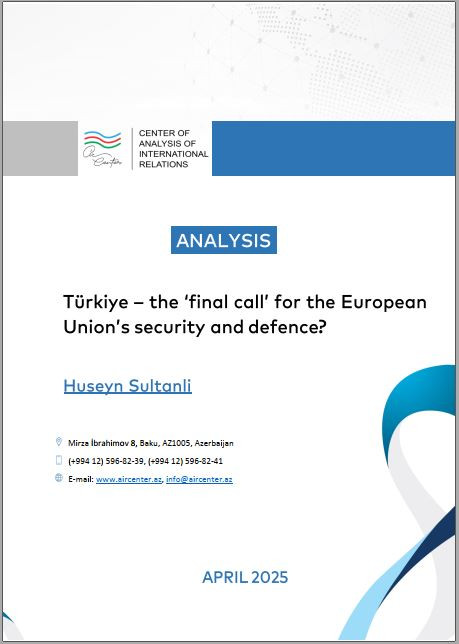As is known, every year landmines lead to the death and injury of thousands of people, in some cases even after a conflict has been resolved. It would be useful to know that at least 60 states, including Azerbaijan, are still contaminated with landmines. In other words, more than 60 million people estimated to be living in areas affected by landmines around the world.
On May 30-31, 2024, an international conference on mine action was held in Azerbaijan. The 3rd International Conference on “Mitigating the Environmental Impact of Landmines: Resource Mobilization for a Safe and Green Future” was jointly organized by the Azerbaijan National Agency for Mine Action (ANAMA) and the United Nations Development Programme (UNDP). Over 300 people from 75 nations, including representatives of international organizations attended the conference.
The main purpose of the conference was to draw the attention of the world community to the mine problem in Azerbaijan. Also, the conference aimed to strengthen international partnership in the field of humanitarian demining, and discuss ways of mobilizing financial resources to reduce the impact of landmines and other explosive remnants of war (ERW) on the environment.
“The steady increase in the number of mine victims is associated with Armenia’s refusal to provide the accurate maps of the mines it planted across Azerbaijan’s territory, and with placing booby traps along the roads, cemeteries, and other civilian facilities located behind the former line of contact,” said by the President of the Republic of Azerbaijan Ilham Aliyev in his address to the participants of the conference.
Mines, unexploded devices and booby traps are amongst the most menacing and hazardous leftovers of Armenian occupation in Karabakh region of Azerbaijan. Armenia’s occupation that lasted almost three decades has resulted in contamination of the vast swathes of land and caused many casualties. Since the end of the war in 2020, 361 of our citizens, mostly civilians, have fallen victim to mine explosion, resulting in 68 deaths and 293 severe injuries. Overall, since the beginning of Armenia’s aggression against Azerbaijan, over 3400 of our citizens have suffered from mines, including 358 children and 38 women.
According to the initial estimates, roughly 12 percent of the country’s territory is polluted by 1.5 million mines and an unknown number of unexploded ordnances. As seen, Azerbaijan’s Karabakh is one of the highly polluted regions in the world in terms of mine contamination. This poses considerable risks and hazards to ecosystems of the South Caucasus region in general, and Karabakh in particular.
These remnants of the conflict still continue to cause death and injury of Azerbaijanis. After the trilateral statement signed on November 10, 2020 Armenian forces had mined the territories and supply roads of Azerbaijani army units. After the conflict with Armenia ended in 2020, Azerbaijani Ministry of Defense claimed to have cleared a total of 1,318 PMN-E antipersonnel mines in the Lachin region. Also, in September 2022, the Azerbaijani MoD released a statement, along with a video, claiming to have found 100 Armenian-made PMN-E antipersonnel mines, eight PMN-2 antipersonnel mines, and 10 antivehicle landmines. Since these assertions emerged, reputable technical sources have confirmed their production in Armenia.
Interestingly enough, in September 2022, it was reported that Armenia had ordered the Pinaka multi-barrel rocket launcher from India, which is also designed for the remote deployment of anti-personnel and anti-tank minefields. However, it is not known if this order included the antipersonnel mine laying variant of the system.
To resolve the problem, an accurate map of mined areas has been requested from Armenia over and over again. By disregarding international law, Armenia, under various pretexts, unfortunately rejects constantly giving the accurate map of the landmines that were produced and planted by themselves.
As mentioned above, long after conflicts have ended, the legacy of landmines remains. Despite the fact that landmines were originally developed for military use, they have also had a deep and permanent impact on civil people. In other words, it has a devastating impact on the movement of refugees, and hinders their return. Consequently, eliminating the threat of mines and ERW is a crucially important for saving civilian’s lives. For individuals and communities alike, the impact of landmines is not simply physical, it is also psychological, social, and economic. Landmines therefore pose a serious and constant threat to civilians. For that reason, tackling the threat of landmine and ERW contamination requires to be properly addressed by international community.
Taking this into consideration, the government of Azerbaijan has declared humanitarian demining as among top policy priorities. Azerbaijan has launched multiple initiatives to raise awareness and seek assistance for mine action. In this regard, in May, 2023, Azerbaijan initiated efforts to include mine clearance as the 18th Sustainable Development Goal by 2030 on the UN agenda. The Mine Action Agency of the Republic of Azerbaijan (ANAMA) signed a Statement of Intent with UNDP on cooperation in establishment of the ANAMA-UNDP International Centre of Excellence and Training for Mine Action in the territory of Azerbaijan on May 30, 2024. Moreover, Azerbaijan exchanges its growing de-mining expertise with other countries. Azerbaijan has sent Revival P mine clearance vehicles to Ukraine and shared innovative demining technologies and methods.
Overall, as it stands, the presence of landmines and other unexploded munitions prevents civilians from returning to their homes by terrorizing and threatening humanitarian activities in Karabkh, Azerbaijan. Also, a mine-contaminated region has detrimental effects not only on the social and economic growth, but also on the rehabilitation of the local population as people cannot move around freely even if they return back their homes.
To conclude, demining is an important element of Azerbaijan-Armenia normalization deal, and therefore should be supported more vigorously by the international community. Despite repeated appeals to international organizations and authorities of Armenia, they still have not presented the exact map of mines to Azerbaijan. On the contrary, that can also be considered as a measure of confidence building between the parties and serve advancing peace agenda.







